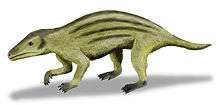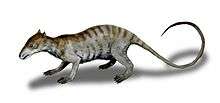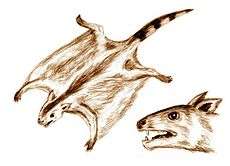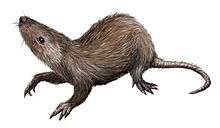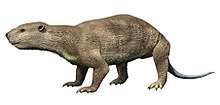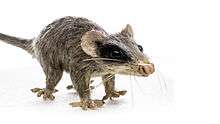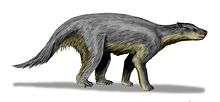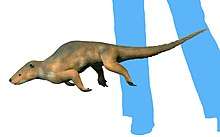Zalambdalestes
Zalambdalestes (meaning much-like-lambda robber) was a eutherian mammal, most likely not a placental due to the presence of an epipubic bone,[1][2] living during the Upper Cretaceous in Mongolia.

| Zalambdalestes | |
|---|---|
 | |
| Zalambdalestes lechei skull and lower jaw, Museum of Evolution Warsaw. | |
| Scientific classification | |
| Kingdom: | |
| Phylum: | |
| Class: | |
| Infraclass: | |
| Family: | |
| Genus: | Zalambdalestes |
| Species | |
| |
Zalambdalestes was a hopping animal with a long snout, long teeth, a small brain and large eyes. It was about 20 centimetres (7.9 in) long, with a head only 5 centimetres (2 in) long. It had strong front paws and even stronger rear ones, sharing specializations to saltation similar to those of modern rabbits.[2][3]
Its diet was probably composed mainly of insects that it hunted in the forest undergrowth using its sharp, interlocking teeth.[4] Unlike modern placental mammals, Zalambdalestes had an epipubic bone, meaning it was probably restricted reproductively in the same way as modern monotremes and marsupials.[2]
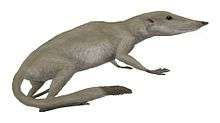
References
- Parker, Steve. Dinosaurs: the complete guide to dinosaurs. Firefly Books Inc, 2003. Pg. 402
- Dykes, Kevin T. "Mesozoic Mammals; Zalambdalestidae, Lipotyphla?, Cimolestidae and Cretaceous Taeniodonta". Mesozoic Eucynodonts. Archived from the original on March 4, 2006.
- Rose, Kenneth D.; Archibald, J. David, eds. (2005). The Rise of Placental Mammals: Origins and Relationships of the Major Extant Clades. Johns Hopkins University Press. ISBN 9780801880223.
- Chen, Meng; Wilson, Gregory P. (2015). "A multivariate approach to infer locomotor modes in Mesozoic mammals". Paleobiology. 41 (2): 280–312. doi:10.1017/pab.2014.14.
- Palmer, D., ed. (1999). The Marshall Illustrated Encyclopedia of Dinosaurs and Prehistoric Animals. London: Marshall Editions. p. 201. ISBN 1-84028-152-9.
Further reading
- Wible, John R.; Novacek, Michael J.; Rougier, Guillermo W. (2004). "New data on the skull and dentition in the Mongolian Late Cretaceous eutherian mammal Zalambdalestes" (PDF). Bulletin of the American Museum of Natural History. 281: 1–144. doi:10.1206/0003-0090(2004)281<0001:NDOTSA>2.0.CO;2. hdl:2246/449.

